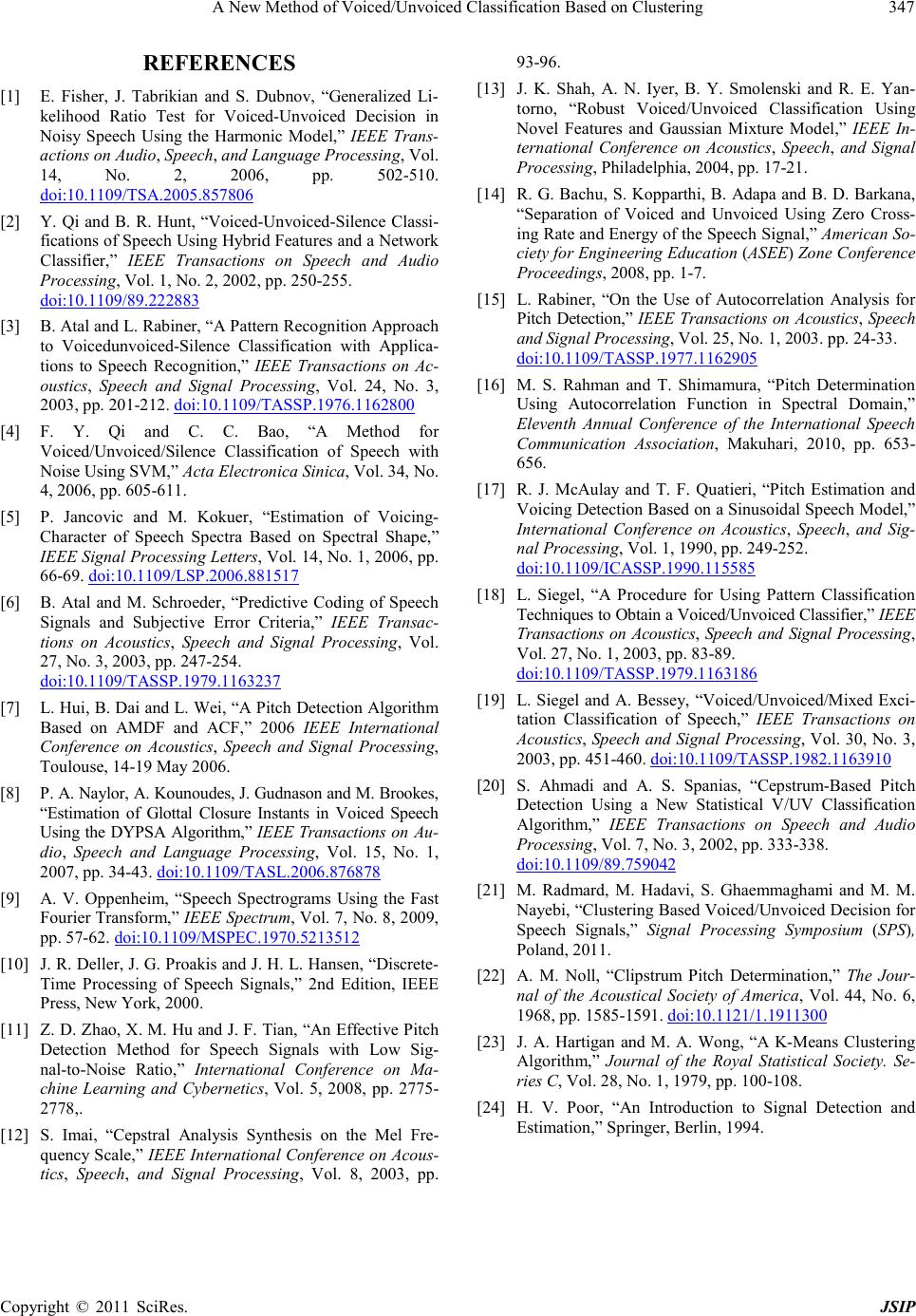
A New Method of Voiced/Unvoiced Classification Based on Clustering
Copyright © 2011 SciRes. JSIP
REFERENCES
[1] E. Fisher, J. Tabrikian and S. Dubnov, “Generalized Li-
kelihood Ratio Test for Voiced-Unvoiced Decision in
Noisy Speech Using the Harmonic Model,” IEEE Trans-
actions on Audio, Speech, and Language Processing, Vol.
14, No. 2, 2006, pp. 502-510.
doi:10.1109/TSA.2005.857806
[2] Y. Qi and B. R. Hunt, “Voiced-Unvoiced-Silence Classi-
fications of Speech Using Hybrid Features and a Network
Classifier,” IEEE Transactions on Speech and Audio
Processing , Vol. 1, No. 2, 2002, pp. 250-255.
doi:10.1109/89.222883
[3] B. Atal an d L. Rab in er, “A P atter n R ecogn ition Approach
to Voicedunvoi ced-Silence Classification with Applica-
tions to Speech Recognition,” IEEE Transactions on Ac-
oustics, Speech and Signal Processing, Vol. 24, No. 3,
2003, pp. 201-212. doi:10.1109/TASSP.1976.1162800
[4] F. Y. Qi and C. C. Bao, “A Method for
Voiced/Unvoiced/Silence Classification of Speech with
Noise Using SVM,” Acta Electronica Sinica, Vol. 34, No.
4, 2006, pp. 605-611.
[5] P. Jancovic and M. Kokuer, “Estimation of Voicing-
Character of Speech Spectra Based on Spectral Shape,”
IEEE Signal Processing Letters, Vol. 14, No. 1, 2006 , pp .
66-69. doi:10.1109/LSP.2006.881517
[6] B. Atal and M. Schroeder, “Predictive Coding of Speech
Signals and Subjective Error Criteria,” IEEE Transac-
tions on Acoustics, Speech and Signal Processing, Vol.
27, No. 3, 2003, pp. 247-254.
doi:10.1109/TASSP.1979.1163237
[7] L. Hui, B. Dai and L. Wei, “A Pitch Detection Algorithm
Based on AMDF and ACF,” 2006 IEEE International
Conference on Acoustics, Speech and Signal Processing,
Toulouse, 14-19 May 2006.
[8] P. A. Naylor, A. Kounoudes, J. Gudnason and M. Brookes,
“Estimation of Glottal Closure Instants in Voiced Speech
Using th e DYPSA Algorithm,” IEEE Transactions on Au-
dio, Speech and Language Processing, Vol. 15, No. 1,
2007, pp. 34-43. doi:10.1109/TASL.2006.876878
[9] A. V. Oppenheim, “Speech Spectrograms Using the Fast
Fourier Transform,” IEEE Spectrum, Vol. 7, No. 8, 2009,
pp. 57-62. doi:10.1109/MSPEC.1970.5213512
[10] J. R. Deller, J. G. P ro ak is and J. H. L. Hansen , “Discrete-
Time Processing of Speech Signals,” 2nd Edition, IEEE
Press , New York, 2000.
[11] Z. D. Zhao, X. M. Hu and J. F. Ti an, “An Effecti ve Pitch
Detection Method for Speech Signals with Low Sig-
nal-to-Noise Ratio,” International Conference on Ma-
chine Learning and Cybernetics, Vol. 5, 2008, pp. 2775-
2778,.
[12] S. Imai, “Cepstral Analysis Synthesis on the Mel Fre-
quen cy Scale,” IEEE International Conference on Acous-
tics, Speech, and Signal Processing, Vol. 8, 2003, pp.
93-96.
[13] J. K. Shah, A. N. Iyer, B. Y. Smolenski and R. E. Yan-
torno, “Robust Voiced/Unvoiced Classification Using
Novel Features and Gaussian Mixture Model,” IEEE In-
ternational Conference on Acoustics, Speech, and Signal
Processing , Philadelphia, 2004, pp. 17-21.
[14] R. G. Bachu, S. Kopparthi, B. Adapa and B. D. Barkana,
“Separation of Voiced and Unvoiced Using Zero Cro ss-
ing Rate an d Energy of the S peech Signal,” A merica n S o-
ciety for Engineering Education (ASEE) Zone Conference
Proceedings, 2008, pp. 1-7.
[15] L. Rabiner, “On the Use of Autocorrelation Analysis for
Pitch Detection,” IEEE Transactions on Acoustics, Speech
and Signal Processing, Vol. 25, No. 1, 2003. pp. 24-33.
doi:10.1109/TASSP.1977.1162905
[16] M. S. Rahman and T. Shimamura, “Pitch Determination
Using Autocorrelation Function in Spectral Domain,”
Eleventh Annual Conference of the International Speech
Communication Association, Makuhar i, 2010, pp. 653-
656.
[17] R. J. McAulay and T. F. Quatieri, “Pitch Estimation and
Voi cing Detectio n Based on a Sinusoidal Speech Model,”
International Conference on Acoustics, Speech, and Sig-
nal Proc e s s ing, Vol. 1, 1990, pp. 249-252.
doi:10.1109/ICASSP.199 0.115585
[18] L. Siegel, “A Procedure for Using Pattern Classification
Techniques to Obtain a Vo iced /Un voi ced Cl as si fier ,” IEEE
Transactions on Acoustics, Speech and Signal Processing,
Vol. 27, No. 1, 2003, pp. 83-89.
doi:10.1109/TASSP.1979.1163186
[19] L. Siegel and A. Bessey, “Voiced/Unvoiced/Mixed Exci-
tation Classification of Speech,” IEEE Transactions on
Acou stics, Speech and Signal Processing, Vol. 30, No. 3,
2003, pp. 451-460. doi:10.1109/TASSP.1982.1163910
[20] S. Ahmadi and A. S. Spanias, “Cepstrum-Based Pitch
Detection Using a New Statistical V/UV Classification
Algorithm,” IEEE Transactions on Speech and Audio
Processing, Vol. 7, No. 3, 2002, pp. 333-338.
doi:10.1109/89.759042
[21] M. Radmard, M. Hadavi, S. Ghaemmaghami and M. M.
Naye bi, “Cluster ing Based Voiced/Un voiced Decis ion for
Speech Signals,” Signal Processing Symposium (SPS),
Poland, 2011.
[22] A. M. Noll, “Clipstrum Pitch Determination,” The Jour-
nal of the Acoustical Society of America, Vol. 44, No. 6,
1968, pp. 1585-1591. doi:10.1121/1.1911300
[23] J. A. Hartigan and M. A. Wong, “A K-Means Clustering
Algorithm,” Journal of the Royal Statistical Society. Se-
ries C, Vol. 28, No. 1, 1979, pp. 100-108.
[24] H. V. Poor, “An Introduction to Signal Detection and
Estimation,” Springer, Berlin, 1994.